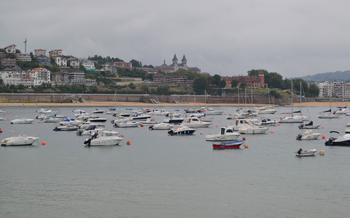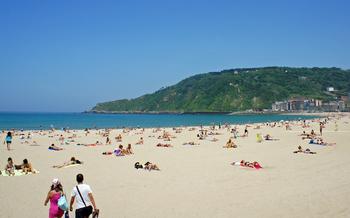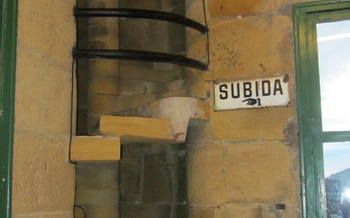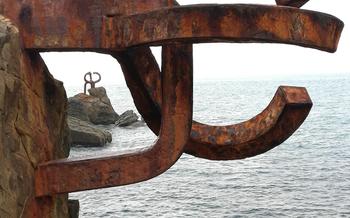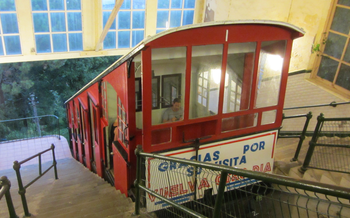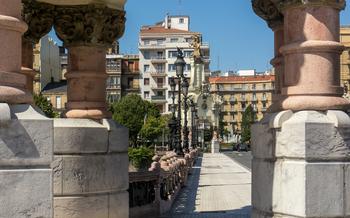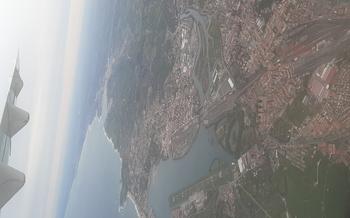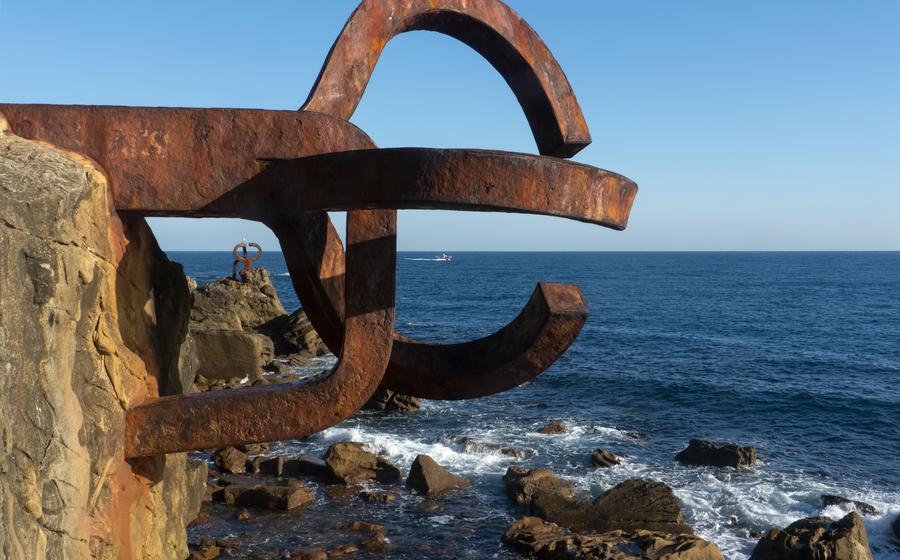
Peine del Viento
- Peine del Viento: An Artistic Masterpiece
- Location: A Scenic Seaside Setting
- History: From Concept to Creation
- Design and Structure: A Fusion of Art and Engineering
- Symbolism and Meaning: A Deeper Message
- Artistic Significance: A Masterpiece of Contemporary Art
- Experiencing the Peine del Viento: A Sensory Journey
- Best Time to Visit: Capturing the Essence
- Photography Tips: Capturing the Beauty
- Accessibility: Ensuring Inclusivity
- Guided Tours: Unveiling Hidden Stories
- Nearby Attractions: Exploring San Sebastián
- Local Cuisine: A Culinary Adventure
- Accommodations: Rest and Relaxation
- Insider Tip: Unveiling a Hidden Gem
Peine del Viento: An Artistic Masterpiece
The Peine del Viento, or "Comb of the Wind," is a captivating sculpture that stands as a testament to the creativity and vision of renowned Basque artist Eduardo Chillida. Unveiled in 1977, this iconic artwork has become a symbol of San Sebastián and a must-see attraction for visitors from around the world.
Chillida's inspiration for the Peine del Viento came from the rugged beauty of the Basque coastline and the relentless force of the wind that shapes it. The sculpture consists of three monumental steel combs, each weighing several tons, that are anchored into the rocks at the end of the Paseo de la Concha. The combs are arranged in a triangular formation, creating a dynamic composition that interacts with the surrounding landscape.
The Peine del Viento is not merely an aesthetic spectacle; it is also a profound exploration of the relationship between humans and nature. The sculpture's title, "Comb of the Wind," evokes the idea of the wind as a powerful force that can both nurture and destroy. The combs, with their sharp teeth, symbolize the wind's ability to both caress and wound.
The Peine del Viento has become an integral part of San Sebastián's identity. It is a symbol of the city's resilience and its deep connection to the sea. The sculpture has also gained international recognition, earning Chillida widespread acclaim and solidifying his position as one of the most influential sculptors of the 20th century.
Location: A Scenic Seaside Setting
The Peine del Viento is strategically positioned on the Paseo de la Concha, a picturesque promenade that hugs the coastline of San Sebastián. This prime location not only provides breathtaking views of La Concha Bay and the surrounding landscape but also enhances the impact and significance of the sculpture.
The sculpture's setting is an integral part of its overall experience. The crashing waves, the gentle sea breeze, and the panoramic vistas combine to create a captivating atmosphere that draws visitors in. The Peine del Viento becomes more than just a work of art; it transforms into a living, breathing entity that interacts with its surroundings and invites viewers to engage with it on a deeper level.
Visitors can stroll along the Paseo de la Concha and admire the sculpture from afar, appreciating its grandeur and scale. As they approach, the sound of the waves reverberates through the steel combs, creating a unique auditory experience that adds to the immersive nature of the artwork. The interplay of light and shadow on the sculpture's surfaces, as well as the changing colors of the sky and sea, further enhance its visual appeal.
The Peine del Viento's proximity to other attractions and landmarks in San Sebastián makes it an ideal destination for visitors exploring the city. The sculpture is situated within easy walking distance of La Concha Beach, the Parte Vieja (Old Town), and the Miramar Palace, among other notable sites. This allows visitors to combine their visit to the Peine del Viento with other cultural and historical experiences, creating a comprehensive and enriching itinerary.
History: From Concept to Creation
The Peine del Viento's journey from concept to creation was a complex and fascinating process. The idea for the sculpture was born in the mind of renowned Basque sculptor Eduardo Chillida, who was inspired by the rugged beauty of the Basque coastline and the relentless force of the wind and waves. Chillida collaborated with architect Luis Peña Ganchegui to bring his vision to life.
The project faced numerous challenges from the outset. The location, exposed to the full force of the Atlantic Ocean, required a design that could withstand the powerful waves and corrosive salt air. Chillida and Peña Ganchegui spent years meticulously engineering the sculpture, ensuring its structural integrity and resilience.
Despite the challenges, the Peine del Viento was finally completed in 1977 and inaugurated on September 25th of that same year. The sculpture's unveiling was a momentous occasion for San Sebastián and the Basque Country, solidifying Chillida's status as one of the most influential artists of his time.
Design and Structure: A Fusion of Art and Engineering
The Peine del Viento is a sculpture characterized by its distinctive design, consisting of three steel combs, each weighing several tons, that stand tall against the backdrop of the sea. These combs are arranged in a row, creating a sense of rhythm and movement. The sculpture is anchored to the rocky shoreline, with its base made from granite blocks that blend seamlessly with the natural surroundings.
Eduardo Chillida collaborated closely with architect Luis Peña Ganchegui to ensure the structural integrity of the sculpture, given its exposed location to the elements. The combs are designed to withstand powerful waves and winds, thanks to their aerodynamic shape and the use of corrosion-resistant steel. The sculpture's positioning and orientation allow the wind to pass through the combs, creating a melodic whistling sound that adds to the immersive experience.
The materials used in the construction of the Peine del Viento play a significant role in its overall impact. The steel combs, with their smooth, polished surfaces, contrast with the rough, textured granite base, representing the interplay between the forces of nature and the enduring strength of human creation. The concrete platform that extends from the shoreline provides a stable foundation for visitors to admire the sculpture from up close.
The Peine del Viento's unique design and structure have made it an iconic landmark of San Sebastián, embodying the city's blend of natural beauty and artistic innovation. It stands as a testament to the power of human creativity to transform the landscape and create a lasting connection between art and nature.
Symbolism and Meaning: A Deeper Message
Beneath its striking exterior, the Peine del Viento carries a profound symbolic meaning that transcends its physical form. It represents the eternal struggle between humanity and the forces of nature, embodying the Basque people's resilience and their deep connection to the sea. The sculpture's three steel combs evoke the fingers of a giant hand reaching out to tame the wild Atlantic waves, symbolizing humanity's attempt to control and harness the power of nature.
The wind, an ever-present force in San Sebastián, plays a crucial role in the sculpture's symbolism. It whistles through the combs, creating a haunting melody that echoes the Basque people's centuries-old struggle against the elements. The sound of the wind, combined with the crashing waves and the salty sea spray, creates a multisensory experience that immerses visitors in the raw power of nature.
The Peine del Viento also symbolizes the Basque people's deep connection to the sea. The Basque Country has a rich maritime history, and the sea has played a vital role in shaping the Basque identity. The sculpture's location on the Paseo de la Concha, overlooking the vast expanse of the Atlantic Ocean, reinforces this connection and serves as a reminder of the Basque people's seafaring heritage.
Finally, the Peine del Viento has become a symbol of resilience and strength for the Basque people. Despite centuries of political and cultural oppression, the Basque people have maintained their unique identity and culture. The sculpture stands as a testament to their unwavering spirit and their ability to withstand adversity.
Artistic Significance: A Masterpiece of Contemporary Art
Eduardo Chillida's Peine del Viento holds a significant position within his artistic trajectory, marking a pivotal moment in his exploration of abstract forms and the relationship between art and nature. As a seminal work of contemporary art, the sculpture has garnered widespread recognition and acclaim, solidifying Chillida's status as one of the most influential artists of his time.
The Peine del Viento's unique design and evocative symbolism have earned it numerous accolades and prestigious awards, including the Grand Prize for Sculpture at the Venice Biennale in 195This international recognition cemented the sculpture's place among the most celebrated works of contemporary art, establishing it as a symbol of artistic innovation and experimentation.
Beyond its individual significance, the Peine del Viento has become a touchstone for understanding Chillida's artistic philosophy and creative process. Its exploration of the interplay between natural elements and abstract forms has influenced countless contemporary artists, inspiring them to push the boundaries of traditional artistic expression and explore new modes of artistic dialogue.
Other notable works by Chillida, such as the "El Pez" and "Homenaje a Jorge Oteiza," share a similar preoccupation with the relationship between art and nature. These works, characterized by their monumental scale and abstract forms, invite viewers to contemplate the essence of the natural world and its profound impact on the human experience.
Collectively, Chillida's works, including the Peine del Viento, have left an enduring legacy in the world of contemporary art, challenging conventional notions of form and meaning and inviting viewers to engage with the power and beauty of the natural world through the lens of artistic expression.
Experiencing the Peine del Viento: A Sensory Journey
Visiting the Peine del Viento is an immersive experience that engages all the senses. The sculpture's commanding presence, combined with the natural elements, creates a sensory symphony that leaves a lasting impression.
The sight of the steel combs against the backdrop of the vast ocean is mesmerizing. The waves crashing against the sculpture, sending sprays of water into the air, add a dynamic element to the visual spectacle. The interplay of light and shadow, especially during sunset, transforms the Peine del Viento into a breathtaking sight.
The sound of the wind whistling through the combs creates a haunting melody. The intensity of the sound changes depending on the wind's strength, creating a unique auditory experience. The crashing waves add a rhythmic beat to the symphony, making the Peine del Viento a truly immersive soundscape.
The sculpture's surface invites visitors to touch and feel its rough, textured steel. The coolness of the metal contrasts with the warmth of the sun, creating a tactile sensation that adds depth to the experience. The rounded edges and smooth curves of the combs allow visitors to interact with the sculpture in a way that is both intimate and awe-inspiring.
The Peine del Viento is more than just a work of art; it is a sensory journey that connects visitors with the elements and themselves. It is a place to pause, reflect, and appreciate the beauty and power of nature, art, and human ingenuity.
Best Time to Visit: Capturing the Essence
To fully appreciate the Peine del Viento's beauty and power, timing is everything. The ideal time to visit is during sunset or sunrise, when the changing light casts a warm glow on the sculpture and the surrounding landscape. The golden hues of the sky create a magical atmosphere, enhancing the sculpture's visual impact and making it a photographer's paradise.
Visiting during different seasons offers unique experiences. In the spring, the vibrant colors of nature complement the sculpture's steel structures, creating a harmonious blend of art and nature. During the summer, the lively atmosphere of San Sebastián's beaches adds to the charm of the Peine del Viento, making it a popular spot for locals and tourists alike.
Winter storms can be particularly dramatic, as the crashing waves and howling winds unleash the full force of nature against the sculpture. Witnessing the Peine del Viento's resilience during these storms is a awe-inspiring sight, showcasing its strength and ability to withstand the elements.
Special events and festivals throughout the year add to the vibrancy of the Peine del Viento experience. During the San Sebastián International Film Festival, the sculpture serves as a backdrop for outdoor screenings, creating a unique cinematic atmosphere. The Tamborrada, an annual drum festival, brings the city alive with music and festivities, making it an ideal time to visit the Peine del Viento and soak up the vibrant energy.
Photography Tips: Capturing the Beauty
The Peine del Viento is a photographer's paradise, offering endless opportunities to capture its beauty and grandeur through the lens. To make the most of your photographic experience, consider the following tips:
-
Use a Tripod: The wind at the Peine del Viento can be unpredictable, so a tripod is essential for keeping your camera steady and avoiding blurry shots.
-
Experiment with Different Angles: Don't just shoot from one spot. Move around the sculpture and try different angles to capture its unique perspectives and relationships with the surrounding environment.
-
Play with Light: The light at the Peine del Viento changes dramatically throughout the day, so experiment with different times of day to capture different moods and atmospheres. Sunset is a particularly magical time to photograph the sculpture as the sky takes on warm hues.
-
Capture the Elements: The Peine del Viento is all about the interaction between the wind, sea, and rock. Try to capture the movement of the waves crashing against the sculpture or the wind whipping through its combs.
-
Be Patient: The best photographs often require patience. Wait for the right moment, whether it's a dramatic wave or a flock of seagulls flying overhead, to create a truly captivating image.
Accessibility: Ensuring Inclusivity
The Peine del Viento is committed to ensuring that all visitors, regardless of their abilities, can enjoy the artwork and its surroundings. Accessibility features have been thoughtfully incorporated to make the sculpture accessible to visitors with disabilities or limited mobility.
Ramps and elevators provide easy access to the sculpture from the Paseo de la Concha, allowing visitors to navigate the site without encountering any barriers. Accessible paths lead visitors directly to the Peine del Viento, ensuring a smooth and comfortable journey.
Visitors with disabilities can avail of special services and assistance to enhance their experience. Trained staff is available to provide any necessary support, ensuring that everyone has an enjoyable and inclusive visit.
While the Peine del Viento is generally accessible, there are a few challenges that visitors should be aware of. The sculpture is located on a rocky coastline, and the ground can be uneven in some areas. Visitors with mobility issues may need assistance when navigating these areas.
Despite these minor challenges, the Peine del Viento remains a welcoming and inclusive space for all visitors. The commitment to accessibility ensures that everyone can appreciate the beauty and significance of this iconic sculpture.
Guided Tours: Unveiling Hidden Stories
Joining a guided tour of the Peine del Viento is an enriching experience that unveils the hidden stories and symbolism embedded within the sculpture. Led by knowledgeable guides, these tours provide insightful commentary on the history, artistic significance, and cultural context of the artwork. Visitors can gain a deeper understanding of Eduardo Chillida's inspiration, the engineering challenges faced during construction, and the sculpture's relationship to San Sebastián and the Basque Country.
Guided tours typically cover various aspects of the Peine del Viento, including its design, construction, symbolism, and reception. Guides may point out specific details, such as the interplay of wind and water, the use of materials, and the symbolic representations of the sea and the wind. They often share anecdotes and historical facts that bring the sculpture to life and enhance the visitor's appreciation.
Several tour operators and companies offer guided tours of the Peine del Viento. Visitors can choose from a range of options, including group tours, private tours, and specialized tours that focus on specific themes or aspects of the sculpture. It is advisable to book a tour in advance, especially during peak tourist season, to secure a spot and avoid disappointment.
Whether you are an art enthusiast, a history buff, or simply curious about the Peine del Viento, joining a guided tour is an excellent way to unlock the secrets of this iconic sculpture and gain a deeper appreciation for its artistic and cultural significance.
Nearby Attractions: Exploring San Sebastián
The Peine del Viento is strategically located within walking distance of several other attractions in San Sebastián, making it easy to combine a visit to the sculpture with a broader exploration of the city.
Just a short stroll away lies the Miramar Palace, a stunning 19th-century palace that now serves as a cultural center and hosts art exhibitions, concerts, and other events. Its lush gardens offer panoramic views of La Concha Bay and the surrounding landscape.
Another nearby attraction is the Aquarium, home to a diverse collection of marine life from the Bay of Biscay and beyond. Visitors can explore the underwater world through interactive exhibits and learn about the importance of marine conservation.
For those interested in history and culture, the San Telmo Museoa is a must-visit. This museum showcases the history and traditions of the Basque Country through a variety of exhibits, including artifacts, paintings, and sculptures.
For a more immersive cultural experience, visitors can head to the Parte Vieja, the historic old town of San Sebastián. This vibrant neighborhood is known for its narrow cobblestone streets, lively bars, and traditional Basque restaurants, offering a taste of the city's rich culinary heritage.
By combining a visit to the Peine del Viento with these nearby attractions, visitors can gain a deeper understanding of San Sebastián's history, culture, and natural beauty.
Local Cuisine: A Culinary Adventure
Visiting the Peine del Viento offers an opportunity to delve into the culinary delights of San Sebastián. The city is renowned for its Basque cuisine, celebrated for its fresh, seasonal ingredients and innovative culinary techniques.
Within walking distance of the sculpture, visitors can find a plethora of local restaurants and eateries catering to diverse tastes and budgets. From traditional Basque pintxos bars serving delectable small plates to Michelin-starred establishments offering exquisite fine dining experiences, there's something for every palate.
Must-try dishes include pintxos such as the classic Gilda (skewers of anchovies, olives, and peppers) and the indulgent Txangurro a la Donostiarra (spider crab in a rich sauce). For a more substantial meal, savor the succulent grilled Txuleta (beef steak) or the hearty Cocido Vasco (Basque stew).
For a truly immersive culinary experience, consider joining a pintxos tour, where you can sample a variety of these small bites while hopping from bar to bar. Many restaurants also offer tasting menus that showcase the best of Basque cuisine, allowing you to sample a range of dishes in one sitting.
Indulging in the local cuisine is an essential part of experiencing San Sebastián. Whether you prefer casual eateries or fine dining establishments, you'll find an array of culinary delights to satisfy your cravings near the Peine del Viento.
Accommodations: Rest and Relaxation
When it comes to finding a place to stay in San Sebastián, you'll be spoilt for choice. The city offers a wide range of accommodations, from budget-friendly hostels and guesthouses to luxurious beachfront hotels. If you're looking for convenience, consider staying in the Gros neighborhood, which is just a short walk from the Peine del Viento. Here, you'll find a variety of hotels and apartments to suit all budgets. For a truly unique experience, book a room at the Hotel Maria Cristina, a historic hotel that has hosted royalty and celebrities throughout its storied history. Whatever your preference or budget, you're sure to find the perfect place to rest and recharge after a day of exploring the Peine del Viento and the many other attractions that San Sebastián has to offer.
Insider Tip: Unveiling a Hidden Gem
Beyond the allure of the Peine del Viento, a hidden gem awaits those willing to venture off the beaten path. Tucked away amidst the rugged coastline, a secluded viewpoint offers a unique perspective that will leave you breathless.
To reach this secret spot, follow the path that leads along the Paseo de la Concha, past the sculpture. As you approach the end of the promenade, you'll notice a small, unassuming staircase carved into the rock face. Descend carefully down the steps, taking in the panoramic views of La Concha Bay that gradually unfold before you.
At the foot of the staircase, you'll find yourself on a secluded platform, surrounded by the crashing waves and the soaring cliffs. From this vantage point, the Peine del Viento takes on a new dimension, its steel combs appearing to dance in harmony with the elements.
Take a moment to soak in the tranquility and marvel at the raw beauty of the surroundings. Let the sound of the waves lull you into a state of serenity as you contemplate the vastness of the ocean and the resilience of the human spirit symbolized by the sculpture.
This hidden gem is a reminder that there's always more to discover, even in the most familiar places. It's a place where you can connect with nature, find solace, and gain a deeper appreciation for the artistic masterpiece that is the Peine del Viento.
